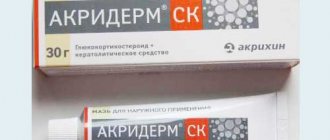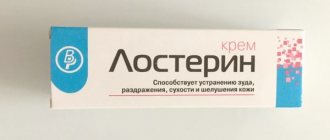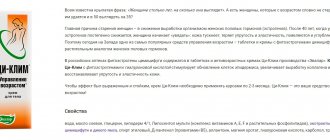Pharmacodynamics and pharmacokinetics
Pharmacodynamics
The active substance clindamycin is an antibiotic of the lincosamide . Depending on the dose, it has a bactericidal and bacteriostatic effect, disrupting protein metabolism in the ribosomal membrane of pathogenic microorganisms.
Gram-positive aerobic and anaerobic bacteria , actinomycetes , mycoplasmas , and bacteroides are sensitive to it . Shows effectiveness in gynecological infections caused by Mycoplasmahominis , Mobiluncus spp ., Gardnerella vaginalis .
Trichomonas vaginalis and candida albicans are resistant to the drug .
All strains of Propioni bacterium acnes are sensitive to clindamycin, which explains its effectiveness in acne vulgaris .
Pharmacokinetics
When taken orally, there is a high (up to 90%) absorption, which is not affected by food intake. The maximum concentration in the blood is determined after 50-60 minutes. Penetrates well into fluids and organs, high concentrations are observed in bone tissue. Metabolized in the liver and excreted in the urine, in small amounts with feces. T 1/2 2-4 hours, with impaired renal function and in the elderly it increases to 5 hours. No accumulation is observed with long-term use.
When administering suppositories for 3 days, 30% of the dose is absorbed into the bloodstream. Cmax in the blood is reached within 1-10 hours, on average 5 hours.
When using the cream for a week, Cmax in the blood is determined after 4-24 hours. Systemic absorption is 5% of the administered dose. The systemic effect with this route of administration is less pronounced than with oral or intravenous administration. T 1/2 is 1.5-2.6 hours.
After applying the gel to the skin, the active substance is hydrolyzed in the ducts of the sebaceous glands and clindamycin , which exhibits antibacterial activity. After external use, a sufficient concentration of the active substance is created in the contents of comedones , and insignificant concentrations are determined in the blood and urine.
Pharmacological properties of the drug Dalatsin vaginal cream
Clindamycin is an antimicrobial agent that is effective against infections caused by sensitive strains of anaerobic as well as gram-positive aerobic bacteria. In vitro active against microorganisms that cause bacterial vaginosis - Gardnerella vaginalis; Mobiluncus spp; Bacteroides spp; Mycoplasma hominis; Peptostreptococcus spp. Does not affect Trichomonas vaginalis and Candida albicans. Cross-resistance of microorganisms to clindamycin and lincomycin was noted. In healthy volunteers, following intravaginal administration of 100 mg clindamycin phosphate once daily at a concentration equivalent to 20 mg clindamycin per 1 g cream, peak serum clindamycin concentrations averaged 20 ng/mL (range, 3–93 ng/mL). Approximately 3% (0.1–7.0%) of the administered dose is absorbed systemically. In women with bacterial vaginosis, after vaginal injection of 5 g of clindamycin phosphate cream (clindamycin 20 mg/g), the amount of clindamycin absorbed is 4% (0.8–8.0%), which is approximately the same as in healthy volunteers.
Indications for use
Dalatsin suppositories and vaginal cream: bacterial vaginitis .
Gel Dalatsin T: treatment of acne , folliculitis , staphyloderma .
Dalacin C capsules and solution:
- otitis , sinusitis , pneumonia , lung abscess , complicated bronchitis ;
- furunculosis , acne, abscesses, erysipelas , osteomyelitis , infected wounds, purulent arthritis ;
- endometritis , colpitis , salpingitis ;
- abdominal abscesses, endocarditis , septicemia, peritonitis ;
- periodontitis and periodontal abscess ;
- malaria;
- prevention of endocarditis , infections during surgical interventions.
Contraindications
Taking the drug orally and parenterally is contraindicated in:
- antibiotic associated colitis;
- hypersensitivity to lincosamides ;
- under 1 month of age;
- severe dysfunction of the liver and kidneys;
- pregnancy and lactation.
Contraindications for the use of cream and suppositories are the first trimester of pregnancy and lactation, for the use of the gel - age under 12 years.
Special instructions for the use of Dalatsin vaginal cream
Before starting treatment, it is necessary to laboratory exclude the presence of pathogenic microflora that are insensitive to the drug - Trichomonas vaginalis, Chlamydia trachomatis, N. gonorrhoeae, Candida albicans and Herpes simplex virus . The use of clindamycin may lead to excessive growth of microorganisms that are not sensitive to it, especially yeast. Diarrhea and cases of pseudomembranous colitis have been reported with the use of almost all antibiotics. In case of severe or prolonged diarrhea, the drug should be discontinued (even despite its minimal amount absorbed after intravaginal use) and, if necessary, appropriate diagnostic and therapeutic measures should be taken. According to clinical trials, intravaginal use of clindamycin phosphate cream in pregnant women in the second trimester, as well as systemic use of clindamycin in the second and third trimester, did not lead to any pathological effects. No adequate and well-controlled studies have been conducted in the first trimester of pregnancy, so during this period the drug should be used only if there are compelling indications. It is unknown whether clindamycin is excreted in breast milk after intravaginal use of clindamycin phosphate. However, clindamycin has been reported to pass into breast milk after oral or parenteral administration, which must be taken into account when considering prescribing the drug during breastfeeding.
Side effects
Gel: dry and irritated skin, contact dermatitis , folliculitis , increased sebum production. Rarely systemic effects occur - nausea, vomiting, diarrhea, and possible development of colitis .
Cream: itching and swelling at the injection site, irritation of the mucous membrane, pain in the vagina, vaginal candidiasis , trichomonas vaginitis , cycle disorders, bleeding. Systemic side effects may include headache, dizziness, dysuria , lower abdominal pain, bloating, diarrhea or constipation , nausea, fungal and bacterial infections , allergic reactions (rash, itching, urticaria ).
Capsules and solution for injection:
- stomach pain, nausea, loose stools, esophagitis , esophageal ulcer ;
- eosinophilia , leukopenia , agranulocytosis , thrombocytopenia ;
- urticaria, rash, itching, epidermal necrolysis ;
- anaphylactic shock (with rapid administration) and anaphylactoid reactions;
- with rapid intravenous administration of the drug - weakness, dizziness, hypertension;
- with intramuscular injection - redness and abscesses at the injection site.
Side effects of the drug Dalatsin vaginal cream
The safety of the drug was studied in clinical studies in both non-pregnant and pregnant patients in the second and third trimester of pregnancy. The following side effects associated with the use of the drug were identified (observed in less than 10% of patients): vaginal candidiasis; irritation of the vulva and vagina; vulvovaginitis; vaginitis caused by Trichomonas vaginalis; menstrual disorders; vaginal pain; metrorrhagia; dysuria; vaginal discharge; urinary tract infections; pathological childbirth; endometriosis; glucosuria and proteinuria. Dizziness and headache were also noted; heartburn, nausea, vomiting, diarrhea, constipation, abdominal pain; allergic reactions (rash, urticaria); candidiasis; fungal infections; generalized or localized abdominal pain; bacterial infections; pain in the pelvic area; bad breath; upper respiratory tract infections; pain throughout the body; backache; abnormalities in microbiological tests.
Instructions for Dalatsin (Method and dosage)
Dalacin C capsules are taken orally, without chewing, simultaneously with meals, with a sufficient amount of water. Adults - 150 mg 4 times a day, in severe cases 300-450 mg 4 times a day, for chlamydial infections 450 mg. Children: 8-25 mg/kg body weight per day, dividing the dose into 4 doses. The duration of the appointment is determined by the doctor.
Cream Dalatsin, instructions for use
A full applicator with cream (5 g) is inserted into the vagina at night, the procedure is carried out as prescribed by the doctor for 3 to 7 days. A plastic applicator is screwed onto a tube of cream and the cream is squeezed into it. After this, unscrew the applicator and, holding it horizontally, insert it deeply into the vagina, while lying on your back with your knees drawn up to your chest. By pressing the piston of the applicator, introduce the cream. The applicator is intended for one-time use.
During treatment, it is recommended to avoid sexual intercourse. Local treatment is not carried out during menstruation. Intravaginal use may cause increased growth of yeast-like fungi.
In the first trimester of pregnancy, intravaginal use of the cream is possible according to absolute indications. Use in the second and third trimesters does not lead to congenital anomalies.
Dalatsin suppositories, instructions for use
Suppositories are administered intravaginally before bedtime, one at a time for 3 days in a row. They can be inserted without an applicator: while lying on your back with your knees drawn up, the candle is inserted as deeply as possible with the middle finger of your hand.
The plastic applicator makes it easier to insert the suppository. The flat end of the suppository is placed into the opening of the applicator. Holding the applicator horizontally, insert it deep into the vagina. By pressing the piston, the suppository is introduced. The applicator can be used several times by washing it with warm water and soap.
The gel is applied in a thin layer only to the affected parts of the skin 2 times a day. Treatment is continued for 6–8 weeks, sometimes up to 6 months. After use for several months, the effectiveness of the drug may decrease; in such cases, a break is taken for a month.
Dalacin vaginal cream 2% tube 20g
Compound
Composition (per 1 g of cream):
active substance
clindamycin (as clindamycin phosphate) 20.0 mg,
Excipients:
sorbitan monostearate 20.0 mg, polysorbate 60 50.0 mg, propylene glycol 50.0 mg, stearic acid 21.4 mg, cetostearyl alcohol 32.1 mg, cetyl palmitate 32.1 mg, mineral oil 64.2 mg, benzyl alcohol 10 .0 mg, purified water qs
Pharmacokinetics
After intravaginal use of clindamycin at a dose of 100 mg per day once (in the form of 2% clindamycin phosphate cream) for 7 days, the serum concentration reaches a maximum approximately 10 hours (4-24 hours) after administration and averages 18 ng/day on the first day. ml (4-47 ng/ml), and on the seventh day - 25 ng/ml (6-61 ng/ml), with systemic absorption accounting for about 4% (0.6-11%) of the administered dose.
In women with bacterial vaginosis, with a similar dosing regimen, about 4% of clindamycin is absorbed (with a smaller range of 2-8%), the serum concentration reaches a maximum approximately 14 hours (4-24 hours) after administration and averages 13 ng/day on the first day. ml (6-34 ng/ml), and on the seventh day -16 ng/ml (7-26 ng/ml).
The systemic effect of clindamycin when administered intravaginally is weaker than when administered orally or intravenously. After intravaginal administration of repeated doses, clindamycin almost does not accumulate in the blood. The systemic half-life is 1.5-2.6 hours.
Use in elderly patients
Clinical studies of clindamycin 2% vaginal cream did not include enough patients aged 65 years or older to evaluate the difference in clinical response to therapy between this age group and younger patients. Available reports from clinical experience have shown no difference in response between older and younger patients.
Indications for use
Bacterial vaginosis.
Contraindications
With intravaginal use of Dalacin cream, absorption of clindamycin is possible in quantities sufficient to cause systemic reactions.
Accidental ingestion of the drug into the gastrointestinal tract can also cause systemic effects similar to those that occur after oral administration of clindamycin in therapeutic doses. Possible systemic side effects include diarrhea, hemorrhagic diarrhea, including pseudomembranous colitis (see sections Side effects and Special instructions).
Treatment: symptomatic and supportive.
Directions for use and doses
Recommended dose: intravaginally, one full applicator (5 g cream, approximately 100 mg clindamycin) preferably at bedtime for 3 or 7 consecutive days.
Directions for use
A package of 20 g of cream contains 3 plastic applicators, and a package of 40 g contains 7 applicators designed for proper insertion of the cream into the vagina.
— Remove the cap of the tube of cream. Screw the plastic applicator onto the threaded neck of the tube.
— Roll the tube from the opposite end and carefully squeeze the cream into the applicator. The applicator is full when the piston reaches the stop.
— Unscrew the applicator from the tube and screw on the cap.
— While lying on your back, pull your knees towards your chest.
— Holding the applicator horizontally, carefully insert it into the vagina as deeply as possible without causing discomfort.
- Slowly pressing the plunger all the way, insert the cream into the vagina.
- Carefully remove the applicator from the vagina and discard it.
Storage conditions
At a temperature not exceeding 25 C. Do not freeze!
Keep out of the reach of children!
Best before date
2 years.
Do not use after the expiration date indicated on the package!
special instructions
Trichomonas vaginalis must be excluded using appropriate laboratory methods.
,
Chlamydia trachomatis
,
Neisseria gonorrhoeae , Candida albicans
and
Herpes simplex virus ,
which often cause vulvovaginitis.
Intravaginal use of clindamycin may lead to increased growth of nonsusceptible microorganisms, especially yeast-like fungi.
The use of clindamycin (like almost all antibiotics) orally or parenterally is associated with the development of severe diarrhea and, in some cases, pseudomembranous colitis. If severe or prolonged diarrhea develops, the drug should be discontinued and, if necessary, appropriate diagnostic and therapeutic measures should be taken.
Patients should be warned that during drug therapy they should not engage in sexual intercourse, or use other means for intravaginal administration (tampons, douching).
The use of Dalatsin cream during menstruation is not recommended.
The initiation of therapy should be delayed until after menstruation.
The drug contains components that can reduce the strength of latex or rubber products, therefore the use of condoms, vaginal contraceptive diaphragms and other latex
for intravaginal use during drug therapy and within 72 hours after use is not recommended.
Description
White cream.
Conditions for dispensing from pharmacies
On prescription
Dosage form
vaginal cream
Pharmacodynamics
Clindamycin phosphate is inactive in vitro ,
but is rapidly hydrolyzed
in vivo
to form clindamycin, which has antibacterial activity. Clindamycin inhibits protein synthesis in microbial cells through interaction with the 50S ribosomal subunit.
In vitro _
The following microorganisms that cause bacterial vaginosis are sensitive to clindamycin:
Gardnerella vaginalis , Mobiluncus
spp.,
Mycoplasma hominis , Bacteroides
spp.,
Peptostreptococcus
spp.
Use during pregnancy and breastfeeding
There have been no adequate controlled studies on the use of the drug in the first trimester of pregnancy, therefore Dalacin vaginal cream can be prescribed to women in the first trimester of pregnancy only for absolute indications, i.e. when the potential benefit of drug therapy for the mother outweighs the potential risk to the fetus.
In animal studies, no adverse effects on the fetus were found when clindamycin was administered subcutaneously or orally, except when the drug was taken in doses toxic to the mother. When clindamycin was used intravaginally in the second or third trimester of pregnancy, no increase in the incidence of congenital anomalies of the fetus was observed. Abnormal birth occurred in 1.1% of women compared with 0.5% in the placebo group when Dalacin vaginal cream was used in the second trimester for 7 days. The use of the drug in the II-III trimester of pregnancy is possible if the potential benefit to the mother outweighs the risk to the fetus.
It is unknown whether clindamycin is excreted into breast milk after intravaginal use. Clindamycin is found in breast milk after oral or parenteral administration, therefore, during breastfeeding, the drug should either be discontinued or breastfeeding should be discontinued, taking into account the importance of the drug for the mother.
Interaction
There is cross-resistance between clindamycin and lincomycin.
Antagonism between clindamycin and
been in
vitro .
It has been established that clindamycin, when administered systemically, disrupts neuromuscular transmission and, therefore, can enhance the effect of peripherally acting muscle relaxants.
Therefore, the drug should be used with caution in patients receiving drugs of this group.
Combined use with other drugs for intravaginal administration is not recommended.
Overdose
With intravaginal use of Dalacin cream, absorption of clindamycin is possible in quantities sufficient to cause systemic reactions.
Accidental ingestion of the drug into the gastrointestinal tract can also cause systemic effects similar to those that occur after oral administration of clindamycin in therapeutic doses. Possible systemic side effects include diarrhea, hemorrhagic diarrhea, including pseudomembranous colitis (see sections Side effects and Special instructions).
Treatment: symptomatic and supportive.
Impact on the ability to drive vehicles and operate machinery
There is no reason to believe that the use of Dalacin vaginal cream can affect the ability to drive a car and operate machinery.
What is the difference between Dalacin and Dalacin T?
As you can see, clindamycin has several dosage forms with different indications and methods of use. Only vaginal cream and suppositories have the name “Dalacin”. In all forms, the active substance is presented in different concentrations.
To treat vaginitis, 2% Dalatsin vaginal cream is used. The suppositories contain 100 mg of clindamycin, and for the treatment of acne , a gel with 1% clindamycin is produced, which has the trade name Dalatsin T. Sometimes the gel and cream are combined under the common name “ointment,” which is not very correct.
What is the difference between Dalatsin and Dalatsin C?
There is another form of release - clindamycin capsules, which are called Dalacin C. Dalacin C capsules are used orally, and Dalacin C Phosphate solution is intended for intravenous and intramuscular injections. These dosage forms have other indications for use.
Dalacin®
Clindamycin phosphate is inactive in vitro, but is rapidly hydrolyzed in vivo to form clindamycin, which has antibacterial activity. Clindamycin belongs to the group of lincosamide antibiotics, which inhibits protein synthesis in microbial cells through interaction with the 50S ribosomal subunit and affects the translation process. Clindamycin, like most protein synthesis inhibitors, is primarily a bacteriostatic, the effectiveness of which is associated with the duration of maintaining the concentration of the active substance at a level higher than the MIC (Minimum Inhibitory Concentration) of the infecting organism.
Resistance to clindamycin in most cases occurs due to modification of ribosomal target sites, usually through chemical modification of RNA nitrogenous bases or point mutations in RNA or sometimes protein mutations. Cross-resistance between lincosamides, macrolides and streptogramins B has been demonstrated in some organisms in vitro. Cross-resistance exists between clindamycin and lincomycin. In vitro, the following microorganisms that cause bacterial vaginosis are sensitive to clindamycin: Gardnerella vaginalis, Mobiluncus spp., Mycoplasma hominis, Bacteroides spp., Peptostreptococcus spp. Bacterial culture and sensitivity studies are not routinely performed to establish the diagnosis and guide treatment of bacterial vaginosis. There is no standard methodology for assessing the susceptibility of potential bacterial vaginosis pathogens (Gardnerella vaginalis, Mobiluncus spp.). Methods for determining the sensitivity of Bacteroides spp and gram-positive anaerobic cocci, also Mycoplasma spp. are described by the Clinical and Laboratory Standards Institute (CLSI), and clindamycin susceptibility breakpoints for gram-negative and gram-positive anaerobic bacteria are published by the European Committee on Antimicrobial Susceptibility Testing (EUCAST). For clinical isolates that are tested to be susceptible to clindamycin but resistant to erythromycin, testing should also be performed to determine clindamycin resistance using the D test. However, breakpoints are intended to guide systemic antibiotic treatment rather than topical treatment.
Overdose
There are no cases of overdose when taking recommended doses orally. When anaphylactic reactions occur, glucocorticosteroids and antihistamines . There is no antidote. Hemodialysis is ineffective.
There are also no reports of overdose of intravaginal cream and suppositories. Systemic reactions may occur: diarrhea , including hemorrhagic , pseudomembranous colitis . Symptomatic therapy is carried out.
Interaction
It enhances the effect of muscle relaxants because it disrupts neuromuscular transmission and has a cross-reaction with lincomycin .
It inhibits the activity of aminoglycosides , macrolides and chloramphenicol . The drug in capsules is not prescribed in conjunction with Erythromycin , Ampicillin , Calcium Gluconate , barbiturates , Magnesium sulfate , Aminophylline .
When prescribed with opioids, the depressant effect on breathing is enhanced.
Cream and suppositories are not recommended for simultaneous use with other drugs for intravaginal administration.
The components of the cream reduce the strength of condoms, so they are not recommended for use when using vaginal cream.
Drug interactions Dalatsin vaginal cream
There is cross-resistance between clindamycin and lincomycin. Antagonism between clindamycin and erythromycin has been demonstrated in vitro No interactions were observed in pharmacodynamic, pharmacokinetic or clinical studies. There is no information on the use of other drugs in combination with clindamycin phosphate cream. Vaginal cream contains mineral oil, which may reduce the strength of products made from latex or rubber, such as condoms or vaginal contraceptive diaphragms. Therefore, the use of these products during treatment with the drug is not recommended.
Analogs
Level 4 ATC code matches:
Zinerite
Zerkalin
Erythromycin ointment
Klindovit
Erythromycin
and Clindatop gel , Clindacin suppositories , Clindacin cream , Clindes , Clindamycin , Clindamycin capsules .
Reviews about Dalatsin
Quite often there are reviews about Dalatsin T gel and it must be said that they are polar. Some people praise this acne gel and note its effectiveness, it does not dry out the skin, eliminates oily shine, removes acne and characterize it as an excellent product.
“It became a salvation,” “dalacin doesn’t help right away.” But many users say that it has a weak effect and high cost compared to analogues.
Many women had to deal with Dalatsin vaginal cream and suppositories when treating vaginitis. Reviews about Dalatsin candles are mostly positive. Women note a good therapeutic effect and ease of use (using an applicator). However, everyone notes a slight burning sensation in the vagina after inserting a suppository.
Reviews for Dalacin cream are mostly negative. First of all, there is a lack of a pronounced effect, a strong burning sensation when administering the cream, and a high cost. “I was treated for a week - there was no result”, “...Dalacin cream did not help me - at first there was an improvement, but after 3 days everything fell into place again”, “caused severe irritation and pain.” Many women prefer Metrogyl .
Dalatsin price, where to buy
You can purchase drugs in pharmacies in Russian cities and other countries. The price of Dalatsin cream 20 g is 529-614 rubles. The price of Dalatsin suppositories ranges from 552-653 rubles, and the price of Dalatsin T gel is 675-826 rubles. Tablets (capsules) are currently not available in Russian pharmacies.
Buying gel in Minsk is also problematic.
- Online pharmacies in RussiaRussia
- Online pharmacies in UkraineUkraine
- Online pharmacies in KazakhstanKazakhstan
LuxPharma* special offer
- Dalacin C phosphate solution for intravenous and intramuscular administration 300 mg/2ml amp.
1 piece 1660 rub. order - Dalacin C capsules 300 mg N16
2900 rub. order
ZdravCity
- Dalatsin vaginal suppositories 100 mg 3 pcs.Pharmacia & Upjohn
RUB 802 order
- Dalatsin gel 1% 30gPharmacia & Upjohn
RUB 1,066 order
Pharmacy Dialogue
- Dalatsin gel (tube 1% 30g)Pharmacia & Upjohn Company
RUB 1,033 order
- Dalatsin (supp. vag. 100 mg No. 3)Pharmacia & Upjohn Company
RUB 896 order
- Dalatsin gel (tube 1% 30g)Pharmacia & Upjohn Company
1160 rub. order
- Dalatsin (sup. vag. 100 mg No. 3)Upjohn/Pfizer
RUR 769 order
- Dalacin vaginal cream (tube 2% 40g)Pharmacia & Upjohn Company
RUB 863 order
show more
Pharmacy24
- Dalacin C Phosphate 600 mg 4 ml N1 solution for injection
328 UAH. order - Dalacin C 300 mg N16 capsules Fareva Amboise, France
393 UAH. order
- Dalacin C Phosphate 300 mg 2 ml No. 1 injection solution
198 UAH order
- Dalatsin 100 mg No. 3 suppositories Pharmacy i Upjohn Company, USA
294 UAH order
- Dalacin C 150 mg N16 capsules Fareva Amboise, France
295 UAH order
PaniPharmacy
- Dalacin C capsule Dalacin C capsules 300 mg No. 16 Belgium, Pharmacia
391 UAH. order
- Dalacin C ampoule Dalacin C phosphate 300 mg amp. 2ml No. 1 Belgium, Pfizer Manufacturing Belgium
202 UAH. order
- Dalacin cream Dalacin vaginal cream 2% 20g, Pharmacia & Upjohn
578 UAH order
- Dalacin C ampoule Dalacin C phosphate 600 mg ampoule 4 ml N1 Belgium, Pfizer Manufacturing Belgium
345 UAH. order
- Dalacin C ampoule Dalacin C phosphate solution for injection 150 mg/ml ampoule 4 ml Belgium, Pfizer Manufacturing Belgium
364 UAH order
show more






